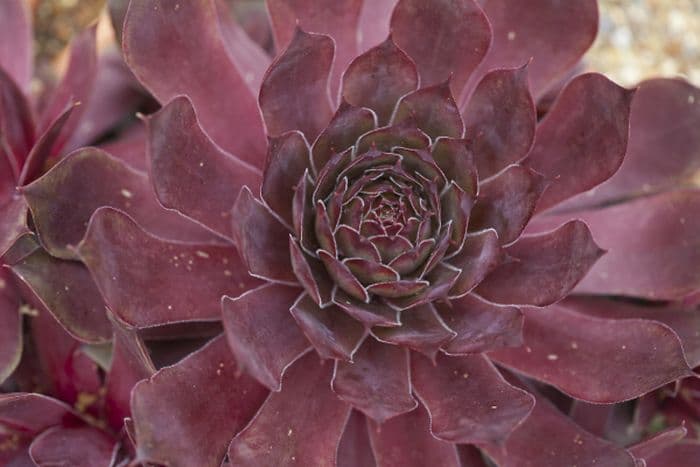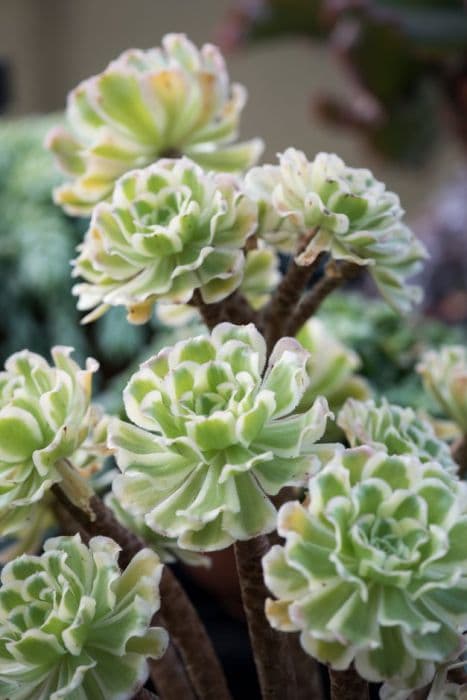Sempervivum 'Othello'

ABOUT
Sempervivum 'Othello', commonly known as Hen and Chicks, is a succulent plant known for its rosette shape and striking visual appeal. This perennial has fleshy leaves that are tightly packed in a circular pattern, emanating from the center outward. The leaves of 'Othello' are particularly notable for their coloration; they exhibit a rich, deep purple to burgundy hue often accentuated with shades of green, especially towards the base. The tips of the leaves may appear slightly pointed, and the surfaces are generally smooth with a somewhat waxy texture. During blooming seasons, Hen and Chicks produces flower spikes that rise above the rosettes, bearing star-shaped flowers. The blooms are typically a contrasting color to the foliage, which can add a striking touch to the display. The overall appearance of Sempervivum 'Othello' is one of robustness and vibrant color, making it a popular choice for rock gardens, container displays, and as ground cover in areas where texture and color interest are desired. As a succulent, it is particularly adept at surviving in dry conditions, storing water within its thick leaves. The moniker "Hen and Chicks" comes from the plant's growth habit; the central "hen" (the main rosette) produces offsets, or "chicks," which cluster around the parent plant and can be separated to propagate new plants. Overall, Sempervivum 'Othello' is both hardy and ornamental, with a distinctive look that is appreciated by succulent enthusiasts and gardeners alike.
About this plant
 Names
NamesFamily
Crassulaceae.
Synonyms
Hen And Chicks, Houseleek, Live Forever.
Common names
Sempervivum 'Othello'.
 Toxicity
ToxicityTo humans
Hen and chicks, commonly known as Sempervivum 'Othello', is not considered toxic to humans. Therefore, ingestion of this plant typically does not lead to poisoning or adverse health effects. However, it is always advisable to avoid eating ornamental plants as a general safety precaution.
To pets
Hen and chicks, the common name for Sempervivum 'Othello', is also not regarded as toxic to pets. Cats, dogs, and other domestic animals would not usually experience poisoning symptoms from ingesting parts of this plant. Nonetheless, keeping an eye on pets and preventing them from eating plants is generally recommended to avoid any unforeseen complications.
 Characteristics
CharacteristicsLife cycle
Perennials
Foliage type
Evergreen
Color of leaves
Mixed
Flower color
Pink
Height
6 inches (15 cm)
Spread
1 foot (30 cm)
Plant type
Succulent
Hardiness zones
4
Native area
Europe
Benefits
 General Benefits
General Benefits- Easy to grow: Sempervivum 'Othello', commonly known as Hen-and-Chicks, requires minimal care and can thrive in a variety of conditions.
- Drought-tolerant: This plant is highly resistant to drought once established, making it suitable for xeric gardens and water-wise landscaping.
- Cold hardy: Hen-and-Chicks can withstand freezing temperatures, making it an ideal choice for outdoor gardens in cold climates.
- Attractive foliage: With its eye-catching rosettes and deep, purple-red coloring, Sempervivum 'Othello' adds aesthetic value to any garden setting.
- Versatile in landscaping: It can be used in rock gardens, containers, green roofs, and as ground cover, adding texture and color contrast.
- Low maintenance: Requires very little attention once settled, no need for regular watering or fertilizing unlike many other garden plants.
- Propagation friendly: Easily propagated through offsets, making it simple to expand your collection or share with others.
- Long living: Being a perennial succulent, it can live for many years and provide lasting enjoyment in the garden.
- Pest-resistant: Less prone to pest issues, reducing the need for chemical pesticides and promoting a healthier garden ecosystem.
- Evergreen: As an evergreen plant, Hen-and-Chicks keeps its foliage year-round, providing interest even in winter months.
 Medical Properties
Medical Properties- Sempervivum 'Othello', commonly known as Hens and Chicks, has been used traditionally for its astringent properties.
- The succulent leaves are known to have been used as poultices for minor skin irritations and cuts.
- Some folk practices also mention its usage to soothe insect bites and stings due to its potential anti-inflammatory effects.
 Air-purifying Qualities
Air-purifying QualitiesThis plant is not specifically known for air purifying qualities.
 Other Uses
Other Uses- Roof Planting: Sempervivum, commonly known as Hens and Chicks, can be used to plant on green roofs due to its tolerance to drought and low maintenance needs, which helps in insulation and reducing urban heat islands.
- Ground Cover: They can be effective ground cover in gardens, covering bare spots with their rosette-forming clusters, which helps reduce soil erosion and suppresses weed growth.
- Garden Art: Hens and Chicks are often used in creating living garden art, such as topiaries or intricate patterns in rock gardens or walkways, due to their varied colors and forms.
- Fairy Gardens: Their small size and unique shapes make Hens and Chicks a popular choice for fairy gardens or miniature landscapes where they can mimic larger plants or trees.
- Vertical Gardens: Sempervivum can be planted on vertical garden walls or structures, adding greenery to urban environments and utilizing unused vertical space.
- Container Gardening: Hens and Chicks are a great addition to container gardens, particularly for those with limited space, as they can thrive in small pots with minimal soil.
- Wedding Decor: Their rosettes and longevity make Hens and Chicks a sustainable choice for wedding bouquets, centerpieces, or favors, lasting well beyond the event.
- Culinary Decoration: Although not for consumption, the rosettes can be used as a non-toxic decorative accent on food platters or as plate garnishes at eco-friendly events.
- Edging Plants: They can serve as attractive and hardy edging along pathways or garden beds, providing a natural border that requires very little upkeep.
- Photography Props: Because of their distinctive form, Hens and Chicks are often used as photography props in outdoor and plant-themed photo shoots.
Interesting Facts
 Feng Shui
Feng ShuiThe Hen and Chicks plant is not used in Feng Shui practice.
 Zodiac Sign Compitability
Zodiac Sign CompitabilityThe Hen and Chicks plant is not used in astrology practice.
 Plant Symbolism
Plant Symbolism- Longevity: Sempervivum, commonly known as Hen and Chicks or Houseleek, symbolizes long life and everlasting love, as they are hardy plants that can survive in harsh conditions and have a long lifespan.
- Self-Reliance: These plants can thrive with minimal care and in poor soil, highlighting their ability to be self-sufficient and independent.
- Protection: Historically, Houseleeks were believed to ward off lightning and fire when grown on rooftops, symbolizing protection and safety against external threats.
- Persistence: Their ability to easily propagate and spread indicates persistence and the capacity to endure through challenges.
- Resilience: Sempervivum's capacity to survive extreme weather and regenerate from damage imparts the symbolism of resilience and recovery.
 Water
WaterHen and chicks, or Sempervivum 'Othello', should be watered infrequently but thoroughly. Allow the soil to dry out thoroughly before watering again which may mean watering every 7-10 days during active growing seasons, depending on climate conditions. When watering, aim to provide enough water so that it runs out of the drainage holes of the container, which may equate to approximately 1-2 gallons for a medium-sized outdoor pot. It's important not to overwater as this plant is drought-tolerant and excess moisture can lead to root rot.
 Light
LightHen and chicks, the common name for Sempervivum 'Othello', thrive in full sun to partial shade conditions. They perform best when they receive at least 6 hours of direct sunlight per day, though they can tolerate some light shade. An ideal spot is in a south-facing location where they can bask in the sun's rays, but they will also do well in an east or west-facing spot that gets ample morning or afternoon sun.
 Temperature
TemperatureFor Hen and chicks, ideal temperatures range between 60°F and 80°F. They can tolerate high temperatures and are frost hardy, usually withstanding temperatures as low as -20°F, making them suitable for many climates. However, during extremely hot weather, it's best to provide some afternoon shade to prevent possible scorching of the leaves.
 Pruning
PruningHen and chicks require minimal pruning. The main reason to prune is to remove dead or damaged leaves and spent flower stalks to maintain plant health and appearance. This is best done in the spring or early summer. Occasional removal of offset pups can be done if you wish to control the spread of the plant or propagate new plants.
 Cleaning
CleaningAs needed
 Soil
SoilHen and chicks, commonly known as Sempervivum 'Othello', thrive in a well-draining soil mix comprising perlite, coarse sand, and peat or compost to retain some moisture. The ideal soil pH for hen and chicks is neutral to slightly alkaline, ranging from 6.6 to 7.5.
 Repotting
RepottingHen and chicks, or Sempervivum 'Othello', should be repotted every 2 to 3 years to refresh the soil and accommodate offset growth. Spring is the best time for repotting this succulent.
 Humidity & Misting
Humidity & MistingHen and chicks, referred to as Sempervivum 'Othello', prefer low humidity levels, typical of arid climates. It abides well in room humidity values around 40-50%.
 Suitable locations
Suitable locationsIndoor
Place hen and chicks in a sunny spot.
Outdoor
Plant hen and chicks in full sun and well-drained soil.
Hardiness zone
3-9 USDA
 Life cycle
Life cycleThe life of Hen-and-chicks 'Othello' begins as a seed or as an offset from a parent plant. The seeds germinate and young rosettes form, entering a juvenile vegetative stage characterized by rapid leaf production. As the rosettes mature, they develop a thick stem and store water in their succulent leaves, becoming drought-resistant. The plant eventually reaches maturity and produces a central flower stalk, upon which star-shaped flowers bloom typically in the summer. After flowering, the monocarpic rosette that bloomed usually dies, but not before producing numerous offsets or "chicks" around its base which continue to grow and propagate the plant. These offsets then independently progress through the same life cycle, ensuring the survival of the species.
 Propogation
PropogationPropogation time
Spring-Summer
The Sempervivum 'Othello', also known as Hen and Chicks, is most commonly propagated through the separation of offsets. These are the small rosettes that form at the base of the parent plant. As they grow, they develop their own roots while still attached to the mother plant. The best time for this propagation method is during the warmer months of spring and early summer when the plant's growth is most active. To propagate, gently twist off an offset, making sure it has some root fibers attached, and then allow the offset to callous for a few days. Once calloused, plant the offset in well-draining soil and keep it lightly moist until it establishes a strong root system, which usually takes a few weeks. This straightforward approach is favored due to its simplicity and high success rate.









